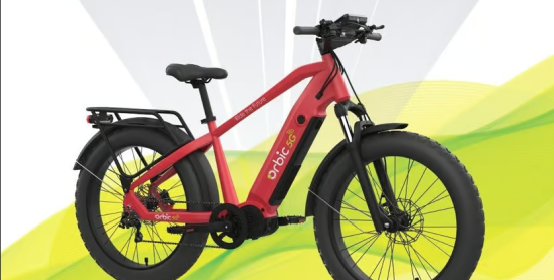
As more and more towns and suburbs put themselves on “road diets” and seek to move away from car-centric urban planning, electronic bikes have become very valuable tools. They make it easier to navigate hills and move along at a good clip, even for riders who're less than athletically gifted. Unfortunately, the promise of greater speed seems to have come before roads and riders were prepared for all of the safety considerations that riding e-bikes entail.
For example, research shows that e-bike and e-scooter accidents and injuries are soaring. What's more, accidents involving e-bikes are three times more likely to involve a pedestrian than either powered scooters or manual bikes. Fortunately, electronics maker Orbic is seeking to change this with the world's first 5G enabled e-bike with built-in crash prevention.
The Orbic 5G e-bike is a fat tire bike designed to work equally well both off road and on. It has a robust frame, hydraulic disk brakes, fenders, suspension fork, safety lights, and a rear rack. It's capable of reaching speeds of up to 28 miles per hour (45km/h)—a speed that could be a lot for an inadequately experienced rider. However, the Orbic bike also includes something that makes it unlike any other bike of its kind: a sophisticated crash detection system.
The Orbic bike has been called a “smartphone on wheels,” and for good reason. Orbic started out creating smartphones, laptops, and tablets, and they've incorporated that technology into their e-bike. The bike is equipped with front- and rear-facing cameras.
The rear-facing camera offers a 2 megapixel resolution and a 140 degree field of view. Its feed is recorded, but also sent to a special artificial intelligence-powered collision detection system. The front-facing camera boasts 64 megapixels, and its feed is recorded as well. There's also a seven inch all-weather touchscreen mounted between the handlebars equipped with its own 8 megapixel camera.
Both cameras allow the e-bike to analyze the scene for potential collisions, while the AI-based collision detection system sends audible and visible alerts to warn riders of potential hazards. The touchscreen display also relays the bike's battery level, current speed, navigation, and more, so riders can focus on the trail ahead of them. Together, the collision detection system and touchscreen display allow users to reduce distractions and concentrate more on keeping themselves—and those around them—safe.
While the Orbic e-bike represents a big step toward greater cyclist and pedestrian safety, it offers a number of other fun benefits, too. The touchscreen display and camera allow riders to take calls or video chat with other users, making group rides easier and more fun and fostering a stronger sense of community between cyclists. The record function of the forward-facing camera allows users to share rides or create uploadable videos. The bike can also act as a mobile hotspot, so users can enjoy connectivity anywhere they go.
Right now, the Orbic 5G e-bike seems very promising. That said, it remains to be seen how well it performs in the real world. Critics are quick to point out that Orbic is an electronics company, and their foray into the e-bike market is very recent. Once cyclists get their hands on the Orbic bike, we'll be able to see exactly how well it performs.
All of that aside, Orbic knows what they're doing when it comes to tech. Even if the Orbic bike itself ends up unable to live up to the hype, the addition of front- and rear-facing cameras, mobile hotspot capabilities, and AI-assisted collision detection represent a significant advancement in e-bike technology that may very well set a new standard for e-bikes going forward.
E-bikes are great for a wide range of cyclists, from trail riders to commuters, but their high speeds can make it more difficult to avoid dangerous crashes. Orbic's new 5G enabled e-bike aims to make riding safer by adding collision detection to protect cyclists, wildlife, and pedestrians alike, and giving users an easy-to-read display so they can keep tabs on their speed, battery life, and potential hazards.